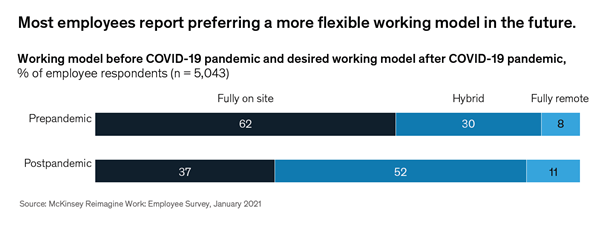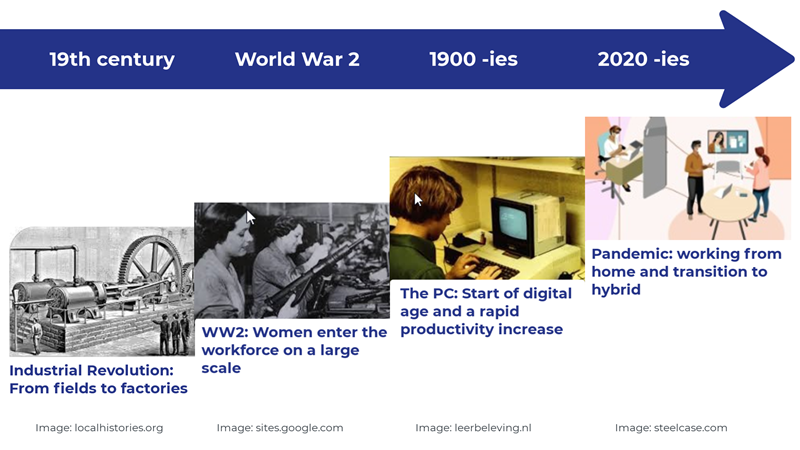In the last post, we looked at the new world of work through the lens of time & place; finding out that hybrid is not just about WHERE people work, but as much about WHEN, and that combining these 2 factors give an innovative perspective on organizing work (November ’21).
This time, we’ll discuss how the new reality of hybrid working is with us and how there is no way back.
Among experts there seems to be a consensus (Gratton, McKinsey, Forrester, HBR) that even if the Covid pandemic comes to an end, there is no ‘back to normal’, meaning everyone back to 5 days in the office.
Having said that, for some jobs, in-person presence will always remain essential. A waiter cannot serve customers from home, nor can a farmer harvest his crop remotely or a baker bake bread anywhere else than in his or her bakery.
But more and more jobs can be handled perfectly well remotely and leaders who think that in a post-Covid situation they can expect all employees to be present in the office from 9 to 5 are not only fooling themselves but also on the way to destroying their human capital.
A recent McKinsey study showed that 29% of the 5000 people surveyed are likely to switch jobs if their employers require them to work exclusively onsite and nearly three quarters of people prefer to work from home for two or more days per week (see graph below).

If leaders ignore this, they will face a disconnect with their employees and risk losing a large amount of talent as well as a drop in motivation and engagement levels.
By contrast, the return to the workplace is a chance to create a new, more effective operating model that works for organizations and its employees. Let’s put it in a historical perspective and see how the transition to hybrid is a paradigm shift when it comes to organizing work.

In the 19th century, there was a massive move of workers from fields to factories during the Industrial Revolution. World War 2 witnessed the entry of women into industry on a large scale. In the 1990-ies, when personal computing and e-mail made their entry, we saw a hug leap in productivity. And now, since the start of pandemic, remote working has become the norm and the role of the office is fundamentally changing.
9 Principles for developing a hybrid model
Currently the Nomadic team is working with the EMEA office of a pharmaceutical company, to prepare their managers for the transition to hybrid. These are the principles and guidelines put in place for this work:
- The purpose is to strike a balance between the needs of the business (the job that needs to be done) and the preferences of employees.
- There is no test & tried model. Every organization is looking to find a model that works for them, and senior management realizes that this requires a learning mindset, with a willingness to take risks, experiment and adjust as we go along.
- Team leaders are given a large amount of autonomy to define what works best for her/his team and set up an agreement amongst all team members.
- No ‘one size fits all’. Different people have different needs and preferences when it comes to the optimal mix between remote and in-person: depending on personality (think of introvert vs extravert preferences), culture, commuting distance, age and generation, family status, tenure.
- All employees have a need for an emotional connection to the company and the team. In addition, the organization benefits from cross-functional connections. Both in-person and online meetings and encounters foster the emotional connection to the company and the social needs of individuals.
- Managing employees’ physical and mental health requires extra attention in a hybrid model, as it is more difficult to monitor team member’s wellbeing remotely.
- Managers need to pay close attention to team dynamics: avoiding an ‘us’ and ‘them’ in teams and departments. The pitfall is that those being present in person may get more exposure, attention, information and opportunities.
- Hybrid meetings require a new skillset: facilitating lively and engaging meetings that include both in person and remote team members
- Trust at the heart of hybrid leadership. The command & control model does not work well in a hybrid setting. Managers cannot control when employees take breaks or look over their shoulder. A shift from input to output based performance management is essential and trust is the foundation of this type of leadership.

Facing this transition with an open and curious mind opens the way to a new, more productive and satisfying way of working in a post-Covid era.

Fredrik Fogelberg is a chartered Organisational Psychologist specializing in leadership development and team facilitation in international organizations. He has over 30 years of international experience in the corporate world and as a consultant.


